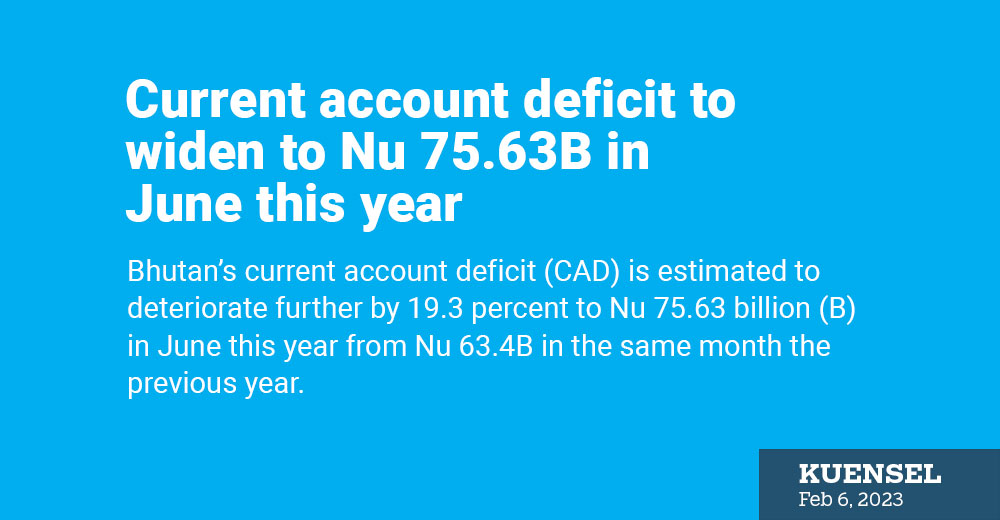…threatening the foreign reserve position for 12 months’ requirement
Thukten Zangpo
Bhutan’s current account deficit (CAD) is estimated to deteriorate further by 19.3 percent to Nu 75.63 billion (B) in June this year from Nu 63.4B in the same month the previous year.
These figures are based on the Macro-economic Framework Coordination Technical Committee of the finance ministry.
The CAD is a measurement of a country’s trade where the value of goods and services it imports exceeds the value of products it exports. It also includes net income, including interest and dividends, and transfers, like foreign aid.
The Royal Monetary Authority, in its recent annual report, stated that the surge in the trade deficits with the increased net service payments and fall in secondary income receipts, the CAD hit an all-time high at Nu 63.4B or 32.9 percent of the gross domestic product (GDP) in the fiscal year 2021-22.
The country’s import bills at Nu 104.13B in the fiscal year 2021-22 saw an increase of 58.9 percent from Nu 65.53B from the previous fiscal year.
With import bills almost doubling the country’s exports at Nu 58.98B in the fiscal year 2021-22, the trade deficits increased by three folds to Nu 45.15B or 23.5 percent of the GDP.
The report estimates that the country’s trade deficits would further deteriorate to 32.6 percent of the GDP in this fiscal year 2022-23.
The commodities such as base metals (iron and steel), machinery, vehicles and transport equipment, and mineral products constituted 60 percent of imports in the fiscal year 2021-22.
However, the electricity export revenue, which constitutes 40.3 percent of the total export, dropped by 9 percent, or Nu 2.45B to Nu 23.71B, because of the shutdown of Chhukha and Tala hydropower for a few months from the previous fiscal year.
The country’s net primary payment, which includes regular servicing for the external debt, widened by 2.3 percent from Nu 11.22B in the fiscal year 2020-21.
The net service payment, which includes freight charges, increased by 66.9 percent from Nu 8.59B in the previous fiscal year. This was because of higher freight payments (Nu 6.1B) on imports from countries other than India.
Also, service exports such as telecommunication, travel and government goods, and services show an improvement of 11.8 percent.
The net secondary income receipts declined by 29.3 percent to Nu 7.66B on account of a substantial drop in non-investment budgetary grant inflows and net inward remittances.
Inward remittances at Nu 6.86B in the fiscal year 2021-22 saw a decrease of 27.6 percent, equivalent to Nu 4.33B from Nu 8.8B from the previous fiscal year.
With the gradual relaxation of labour import, the labour payments or outward remittance doubled from the previous fiscal year’s payment at Nu 2.53B.
Widening CAD, the report stated, would be a threat to the country’s international reserve in the coming years that would jeopardise meeting constitutional requirements of 12 months of essential import coverage, it added.
As of June 2022, the foreign exchange reserves stood at USD 832.9 million against Nu 1.33B in June 2011, a decrease of 37.5 percent.
About 26 percent of the country’s foreign exchange reserve is built on official inflows related to grants and concessional borrowings.
With the inflows in the budgetary grants for non-hydropower development projects remaining almost constant in the medium term, the report stated that the net financial inflow could dwindle, because of the expected increase in hydro-related debt servicing against falling hydropower debt inflows.
Hydro-related grants inflow has declined significantly, with major hydropower projects nearing completion.
The three major hydro plants – Nikachhu, Punatshangchhu I and II have reached more than 85 percent completion, utilising more than 90 percent of the loan disbursements for the projects.
To meet this financing requirement gap, the government will have to maximise borrowings from external conventional windows, including domestic borrowings through the issuance of government securities.
This could push the country’s debt to increase by 4.2 percent or 155.8 percent of the GDP in June this year.
Hydropower debt, projected at Nu 264.71B (80.3 percent of GDP) in June this year, is expected to increase because of construction projects related to Punatsangchhu I and II in the coming years.


